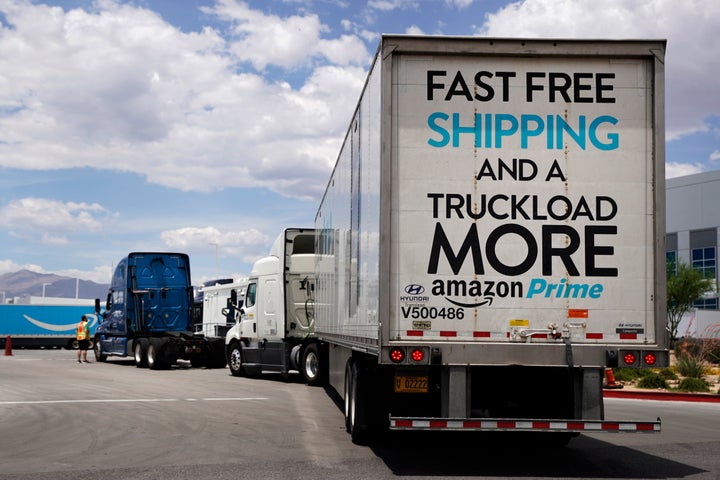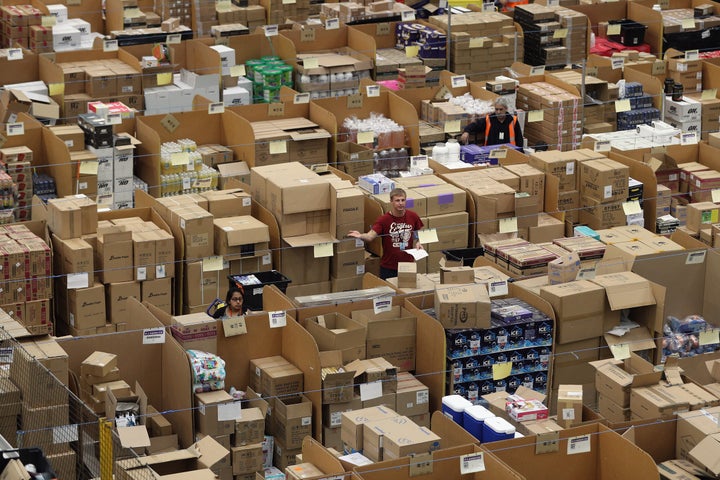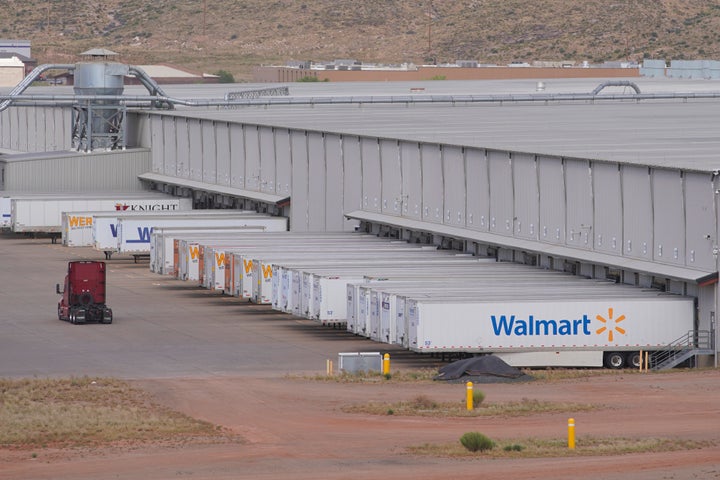Online shopping is becoming easier and easier, with more selection and speedier deliveries. And purchasing everyday items, such as toothpaste and tampons or washing detergent and sponges, is increasingly shifting toward online rather than in-store.
In the U.S., the share of these “fast-moving consumer goods” ― low-priced items that you buy frequently ― being bought online is set to go up from 1.5% in 2017 to 8% by 2025. In the U.K, it’s expected to increase from 7.5% to 12%. How you choose to make these small purchases could have a big effect on your carbon footprint.
What’s the best way to minimize the impact? According to new research, the answer lies somewhere between e-commerce and a good old-fashioned trip to the store.
The study, conducted in the U.K. and published on Wednesday in the journal ”Environmental Science & Technology,” examined the carbon footprint of three ways of shopping: physically going to the store yourself, shopping online the offerings of a traditional store and having your purchases delivered (what it calls “bricks and clicks”), or using online-only retailers like Amazon, which deliver goods from a warehouse.
Researchers considered a number of factors, from the weight of various personal and home care items to the energy usage of shops and warehouses. They found that choosing to shop via “bricks and clicks” rather than driving to the store is most likely to decrease the greenhouse gas emissions of your shopping.
“Where cars are highly used for the purpose of shopping, like in the U.S. and in the U.K., the bricks-and-clicks method often is a greener choice,” said one of the lead authors, Sadegh Shahmohammadi, from the environmental science department at Radboud University Nijmegen in the Netherlands. Having the goods delivered in a van that is also delivering other people’s orders adds up to fewer miles traveled than if each customer had driven to the store and back, Shahmohammadi said.
In the U.S., 95% of shopping trips are made by car. In China or the Netherlands, where the majority of shopping trips are by foot or bike, using the bricks-and-clicks method doesn’t reduce greenhouse gas emissions compared to going to physical stores — and may even be more carbon-intensive.

Still, most studies agree that buying from solely online retailers is often likely to be the most carbon-intensive choice of all — especially if you expect next-day delivery. With so many of us turning to these companies for reliable next-day options, retailers prioritize shipping speed over finding the most efficient route for distributing a large number of orders, so there are likely more back and forth journeys between warehouse and the delivery point.
And more people buying fewer items per purchase not only means more trips overall, but also more packaging. “The number of items purchased has a great impact on the carbon footprints,” says Shahmohammadi. “The more items you buy in one go, the less impact you will have per item purchased.”
Then there are those failed delivery attempts, which result in multiple trips to deliver a single item.
Both the U.K. study and a recent analysis by Miguel Jaller, who studies sustainable transportation systems at the University of California, Davis, found that the most significant environmental impact is likely to arise when goods make their final journey from the store or warehouse to your home.
As Jaller’s research (shared with HuffPost before publication) confirms, the largest contributor to emissions from pure ecommerce companies comes during that last mile of delivery. For physical retailers, the biggest variables are the stores’ energy usage and customers’ chosen mode of transport.
Looking at just that last mile, the authors of the U.K. study estimate that the greenhouse gas emissions for a bricks-and-clicks order are half that of going to the store — and less than one-fifth of ordering from an online-only retailer.
It should be noted, however, that neither of these studies examined the impact of how products are made or how households use and dispose of them. For instance, the return rate for clothing purchased online is a lot higher than clothes bought in-store, which can increase the carbon footprint.

How much you’re buying, how far you’re traveling and the mode of transport you’re using, can all change your shopping’s emissions impact.
If you’re physically going to the store, whether by car or public transit, think about “trip chaining,” as Shahmohammadi calls it: combining your errands with other journeys ― your way home from work, for instance ― to save a roundtrip to the shop.
And for those shopping online, Shahmohammadi and Jaller agree that we should shop slower and bundle our purchases. The more you order next-day delivery, the greater the chance of it being a carbon-intensive option compared to thinking ahead and allowing more items to be delivered at once.
Retailers can support these greener options by making it easier for customers to “forego fast delivery, giving them the option to bundle items and doing actions to prevent failed deliveries,” Shahmohammadi said.
Slowly, some companies are trying to do this. Although it might not always be easy to navigate.
Amazon ― the largest online retailer in the world ― says it aims to keep items to as few packages as possible, depending on availability and your desired delivery day ― but there isn’t always an option for buyers to indicate they want this prioritized. Rather, to increase the chances of this happening you must consciously opt for the later delivery date hoping it will give the company a longer time to acquire and consolidate your items. If you’re an Amazon Prime customer, you’re also able to select a specific day of the week when all your orders are delivered.
It can be tricky to know whether your online purchase is coming from a store or a warehouse, as websites usually don’t clarify this. In order to keep up with customer demand for speedy online shopping, physical retailers like Walmart, Macy’s and HomeGoods are increasingly beefing up their warehouse space. That means your brick-and-click choice may be traveling from farther than your local store.

Shahmohammadi and Jaller agree that companies can make a difference by thinking about that last mile of transport.
In addition to making deliveries more efficient by carefully planning routes and consolidating orders into fewer packages, a retailer can drastically change its emissions by using less emissions-intensive vehicles. In the U.K., Shahmohammadi said, switching from vans to electric cargo-bikes could reduce the carbon footprint associated with the last mile of transport by 42%, and the total footprint of a given purchase by 26%.
“Overall,” said Jaller, all the literature shows that “the money to reduce the impacts lies on the last mile delivery practices ― level of consolidation, vehicle technology ― consumer behavior, and the impacts of customer travel.”
“Apparently,” Shahmohammadi echoed, “both consumers and retailers can make a big change.”
HuffPost’s “Work In Progress” series focuses on the impact of business on society and the environment and is funded by Porticus. It is part of the “This New World” series. All content is editorially independent, with no influence or input from Porticus. If you have an idea or tip for the editorial series, send an email to thisnewworld@huffpost.com.